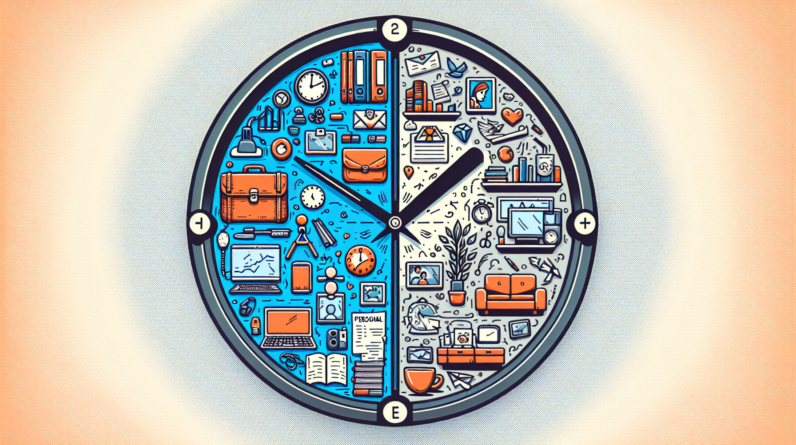
10 Ways To Achieve Work-Life Balance While Working From Home
You’ve made the transition to working from home, but now you’re feeling overwhelmed by the never-ending demands of work and life intertwining. Balancing your professional and personal life can be challenging, especially when your home becomes your office. Don’t worry, though, because we’ve got you covered. In this article, we’ll share 10 invaluable ways to achieve work-life balance while working from home. From setting boundaries to practicing self-care, these tips will help you find harmony in both your professional and personal endeavors without compromising either.

1.- Setting Boundaries
Designate a dedicated workspace
When you are working from home, it is crucial to designate a specific area as your workspace. This could be a separate room, a corner of a room, or even just a desk. By having a dedicated workspace, you create a physical boundary between your work and personal life. It helps you get into the right mindset and signals to others that you are in work mode.
Establish fixed working hours
Having fixed working hours is essential for maintaining a healthy work-life balance while working from home. Set a consistent schedule and stick to it. This will help you create structure in your day and prevent work from bleeding into your personal time. Communicate these working hours to your colleagues and ensure they respect and understand your boundaries.
Communicate your boundaries to others
It’s important to communicate your boundaries to those around you, whether it’s your family members, roommates, or even your pets. Let them know your designated work area and your working hours. This way, they can understand when you need to focus and minimize disruptions. Open communication is key to maintaining a harmonious balance between work and personal life.
2.- Creating a Routine
Start and end your day with a routine
Creating a routine is vital for maintaining work-life balance. Start your day with activities that help you transition into work mode, such as taking a shower, having breakfast, or doing some light exercise. Similarly, establish a routine to wind down at the end of the day, like turning off your work devices or engaging in a relaxing hobby. These routines act as bookends to your workday, helping you establish a clear separation between work and personal time.
Schedule breaks and relaxation time
When you’re absorbed in work, it’s easy to lose track of time and forget to take breaks. However, taking regular breaks throughout the day is crucial for productivity and well-being. Schedule short breaks to stretch, grab a snack, or simply relax. Additionally, allocate time for longer breaks or relaxation activities, such as going for a walk, reading a book, or practicing mindfulness. Remember, breaks are not a luxury but a necessary part of maintaining focus and avoiding burnout.
Plan your tasks and prioritize
To maximize productivity and maintain a healthy work-life balance, it’s important to plan your tasks and prioritize them effectively. Start by creating a to-do list or using productivity tools and apps to stay organized. Break down complex tasks into manageable chunks and allocate realistic deadlines for each. By having a clear plan, you can stay focused and reduce the stress of overwhelming workloads.
Maintain a consistent sleep schedule
A key aspect of work-life balance is ensuring you get enough quality sleep. Establish a consistent sleep schedule by going to bed and waking up at the same time every day. This helps regulate your body’s internal clock and improves sleep quality. Avoid the temptation to stay up late working or engaging in leisure activities, as this can interfere with your sleep patterns and affect your overall well-being.
3.- Managing Distractions
Minimize external distractions
When working from home, there can be numerous distractions that pull your attention away from your work. To maintain focus and productivity, identify and minimize these external distractions. Find a quiet space where you can work without interruptions, close unnecessary tabs or applications on your computer, and inform those around you that you need dedicated focused time. This way, you can create an environment that supports your work goals.
Social media can be a significant source of distraction, especially when working from home. It’s easy to get caught up in scrolling through feeds, checking notifications, and losing track of time. To stay focused, set specific time limits for social media usage and use browser extensions or apps that block access to social media during designated work hours. By reducing the time spent on social media, you can increase your productivity and allocate more time to personal activities.
Use productivity tools and apps
Numerous productivity tools and apps are available to help you stay organized, manage your time efficiently, and minimize distractions. Experiment with different tools and find the ones that work best for you. From time-tracking apps to task management tools to browser extensions that block distracting websites, these tools can provide valuable support in maintaining focus and achieving a healthy work-life balance.
Inform others of your focused time
It can be challenging for others to understand that just because you are at home doesn’t mean you are available at all times. To overcome this, communicate your focused work time to your family members, friends, or roommates. Let them know when you need uninterrupted concentration and ask for their cooperation in minimizing distractions during those times. By setting this expectation, you can create a work environment conducive to productivity and work-life balance.
4.- Establishing Communication
Maintain regular communication with colleagues
When working remotely, it’s crucial to maintain regular communication with your colleagues. This helps foster collaboration, ensures everyone is on the same page, and strengthens team dynamics. Whether it’s through email, instant messaging platforms, or video calls, make an effort to stay connected with your team members. Regular check-ins and updates can create a sense of accountability and help you feel more integrated despite physical distance.
Respect others’ working hours
In a remote work environment, team members may have different working hours or time zones. It is essential to respect others’ working hours and be mindful of when you reach out or schedule meetings. Avoid sending non-urgent messages or requests outside of their designated work hours, as this can disrupt their work-life balance and add unnecessary stress. By being considerate of others’ schedules, you contribute to a positive and supportive work culture.
Utilize appropriate communication channels
Different communication channels serve different purposes. It’s important to use the appropriate channels to ensure effective and efficient communication while respecting work-life boundaries. For urgent matters or time-sensitive issues, opt for instant messaging or phone calls. For non-urgent matters or general updates, email or project management platforms may be more suitable. By using the right communication channels, you can streamline communication and minimize distractions.
Set expectations for response times
In a remote work setup, it’s crucial to set clear expectations for response times. Communicate your availability to your colleagues and let them know when they can expect a response from you. Additionally, be upfront about any specific times when you may be unavailable due to personal commitments or focused work time. By managing these expectations, you can avoid feeling overwhelmed and ensure a healthy work-life balance.

5.- Focusing on Health
Prioritize regular exercise
Physical activity plays a significant role in maintaining overall health and well-being. Incorporating regular exercise into your routine is essential, even when working from home. Schedule time for exercise, whether it’s going for a walk, following an online workout class, or engaging in home-based exercises. Physical activity not only boosts your energy levels but also helps reduce stress and improve mental clarity. Make it a priority to move your body and incorporate exercise into your daily schedule.
Practice mindfulness and relaxation techniques
Maintaining work-life balance goes beyond physical health; it also includes nurturing your mental and emotional well-being. Engage in mindfulness and relaxation techniques to reduce stress, improve focus, and enhance overall happiness. Whether it’s meditation, deep breathing exercises, or practicing gratitude, find techniques that resonate with you and incorporate them into your daily routine. These practices can help you stay present, manage stress, and achieve a sense of balance.
Eat nutritious meals and stay hydrated
When working from home, it’s easy to fall into unhealthy eating habits and forget to stay hydrated. However, proper nutrition is vital for sustaining energy levels and supporting overall well-being. Make a conscious effort to eat balanced meals, including fruits, vegetables, lean proteins, and whole grains. Stay hydrated throughout the day by keeping a water bottle nearby and limiting your intake of sugary drinks. By nourishing your body with nutritious food and staying hydrated, you can maintain optimal health and enhance your productivity.
Take breaks for stretching and movement
Sitting for prolonged periods can negatively impact your physical health and hinder productivity. Combat the sedentary nature of remote work by taking regular breaks for stretching and movement. Get up from your desk, do some simple stretches, or take a short walk around the house. These breaks not only help improve circulation but also give your eyes and brain a rest. By incorporating movement into your breaks, you can stay physically active and maintain a healthy work-life balance.
6.- Maintaining Social Connections
Working remotely can sometimes lead to feelings of isolation and disconnect. To combat this, schedule virtual social activities with your friends, family, or colleagues. Set up virtual coffee breaks, lunch dates, or happy hours where you can connect and chat. These social interactions can provide a much-needed break from work and foster a sense of community and support.
Join online communities or groups
If you find yourself missing the social aspects of working in an office, consider joining online communities or groups related to your industry or interests. These communities provide an opportunity to network, share experiences, and engage in discussions with like-minded individuals. Engaging with others who have similar professional or personal interests can help you feel connected and enhance your work-life balance.
Arrange video calls with friends and family
Stay connected with your loved ones by scheduling regular video calls. Even though physical distance may separate you, technology allows us to bridge that gap and maintain meaningful connections. Plan virtual gatherings, game nights, or even just casual catch-ups with friends and family members. Regular virtual calls can help you feel supported, boost your mood, and remind you that you’re not alone.
Participate in virtual team-building activities
Team-building activities are not limited to physical workplaces. Many companies now organize virtual team-building activities to foster collaboration, connection, and a sense of belonging. Participate actively in these activities, whether it’s virtual trivia, online games, or virtual team challenges. These experiences can help you bond with your colleagues, relieve stress, and create a positive work environment.

7.- Setting Realistic Goals
Break tasks into manageable chunks
Overwhelm can quickly set in when faced with large, complex tasks. To maintain work-life balance and stay productive, break tasks into smaller, more manageable chunks. This allows you to focus on one task at a time and gives you a sense of progress as you complete each piece. By breaking tasks down, you alleviate feelings of overwhelm and increase your ability to accomplish your goals effectively.
Avoid overcommitting or multitasking excessively
One common pitfall of working from home is taking on too many tasks or multitasking excessively. This can lead to reduced productivity, increased stress, and a compromised work-life balance. Avoid overcommitting by being realistic about what you can accomplish within a given timeframe. Focus on one task at a time and allocate dedicated blocks of time for specific projects or activities. By avoiding overcommitment and multitasking, you can maintain focus, complete tasks efficiently, and achieve a healthier work-life balance.
Celebrate small achievements
Acknowledging and celebrating small achievements is an important part of maintaining motivation and a positive mindset. Give yourself credit for completing tasks or reaching milestones, no matter how small they may seem. Celebrate with a treat, take a short break, or share your accomplishment with a colleague or loved one. Recognizing your progress and celebrating your achievements can boost your confidence, enhance your motivation, and contribute to a healthier work-life balance.
Learn to say no when necessary
Setting boundaries also involves being comfortable saying no when necessary. It’s easy to take on additional tasks or favors, but doing so can lead to overload and compromise your work-life balance. Before agreeing to take on something new, assess its impact on your workload and personal commitments. Be honest and assertive about your limitations, and don’t be afraid to decline when it’s necessary to protect your time and well-being.
8.- Taking Regular Breaks
Incorporate short breaks throughout the day
When juggling multiple tasks and responsibilities, it’s important to give yourself regular breaks to recharge and refocus. Incorporate short breaks into your workday, whether it’s a five-minute stretch break every hour or a quick walk around the block. These breaks provide an opportunity to rest your mind, reset your focus, and prevent mental fatigue. Remember, breaks are not a luxury but a necessity for maintaining productivity and work-life balance.
Step away from screens during breaks
During your breaks, it’s important to give your eyes and mind a break from screens. Instead of mindlessly scrolling through social media or watching videos, engage in activities that allow your mind to unwind. Read a book, practice a hobby, or simply enjoy a cup of tea without any distractions. By stepping away from screens, you can reduce eye strain, improve your posture, and create mental space for relaxation and rejuvenation.
Engage in enjoyable activities during breaks
To make the most of your breaks, engage in activities that bring you joy and help you disconnect from work. Listen to music, play a musical instrument, or engage in a creative outlet. These activities can help shift your focus from work-related responsibilities and provide a well-deserved mental break. By intentionally incorporating enjoyable activities into your breaks, you can recharge and return to work with renewed energy and focus.
Try relaxation techniques during breaks
Breaks are an opportune time to practice relaxation techniques that help reduce stress and promote well-being. Experiment with different techniques such as deep breathing exercises, meditation, or guided visualization. These practices can help calm your mind, relieve tension, and improve your overall state of relaxation. By incorporating relaxation techniques into your breaks, you can create a sense of tranquility amidst a busy workday.

9.- Separating Work and Personal Life
Creating physical boundaries between your work and personal life is essential for maintaining a healthy work-life balance. Keep work-related items, such as your laptop, notebooks, or work documents, out of your personal space when you’re not working. This helps create a psychological separation between work and leisure time and prevents the temptation to work during your personal hours. By physically removing work-related items from your personal space, you can establish a clear divide between your professional and personal life.
Maintain separate devices for work and leisure
If possible, maintain separate devices for work and leisure activities. Having a designated work device, such as a laptop or tablet, helps draw a boundary between work-related tasks and personal activities. When you use a specific device for work, you can turn it off or put it away outside of your designated working hours, reducing the temptation to check work-related emails or notifications. By separating your devices, you can create a clear distinction between your professional and personal life.
Avoid checking work emails or messages outside working hours
One of the challenges of working from home is the temptation to check work emails or messages outside of designated working hours. This can quickly blur the lines between work and personal life, leading to increased stress and decreased work-life balance. Respect your personal time by refraining from checking work-related notifications outside of your established working hours. Set clear boundaries for yourself and communicate them with your colleagues, so everyone understands and respects your work-life balance.
Create physical or symbolic boundaries
In addition to physical boundaries, consider creating symbolic or mental boundaries to further separate your work and personal life. For example, you can establish a work ritual, such as lighting a candle or changing into work attire, to signify the start of your workday. Similarly, you can create a ritual to mark the end of the workday, such as closing your work laptop or writing down your accomplishments for the day. These symbolic actions can help your mind transition between work and personal time, reinforcing the boundaries you have set.
10.- Seeking Support
Reach out to mentors or coaches
When working from home, it’s essential to seek support and guidance from mentors or coaches. Connect with experienced individuals in your field who can provide valuable insights and advice. These mentors or coaches can offer guidance on work-related challenges, help you navigate your career, and provide a fresh perspective on achieving work-life balance. By seeking support from mentors or coaches, you can benefit from their knowledge and experience to enhance your professional and personal growth.
Join online support groups for remote workers
Remote work can sometimes feel isolating, especially when faced with unique challenges. Joining online support groups or communities for remote workers can provide a sense of camaraderie and support. These groups offer a platform to share experiences, seek advice, and connect with others in similar situations. By engaging with remote work communities, you can find solidarity, learn from others’ experiences, and gain insights on achieving work-life balance.
Discuss challenges with friends or family
Don’t underestimate the power of discussing your challenges and concerns with friends or family members. Share your experiences and feelings with trusted individuals who can provide emotional support and understanding. They may offer fresh perspectives, advice, or simply lend a listening ear. By opening up about your work-life balance journey, you can alleviate stress, gain new insights, and strengthen your support system.
Consider seeking professional counseling
If work-life balance becomes overwhelming or significantly impacts your well-being, it may be beneficial to seek professional counseling. A counselor or therapist can help you navigate the challenges of remote work, provide strategies for maintaining balance, and support your mental and emotional health. Professional counseling offers a safe and confidential space to explore your concerns and develop coping mechanisms. Remember, seeking professional help is a sign of strength and a proactive step towards achieving a healthier work-life balance.
In conclusion, achieving work-life balance while working from home requires intentionality and consistent effort. By setting boundaries, creating routines, managing distractions, establishing effective communication, prioritizing health, maintaining social connections, setting realistic goals, taking regular breaks, separating work and personal life, and seeking support, you can find harmony in both your professional and personal spheres. Remember, work-life balance is not a one-size-fits-all approach and may require adjustments along the way. Stay mindful, adapt as needed, and prioritize your well-being.







